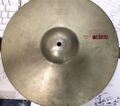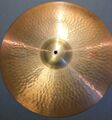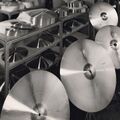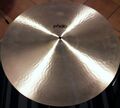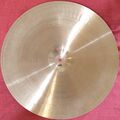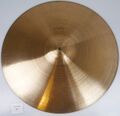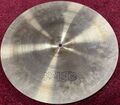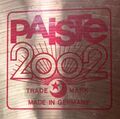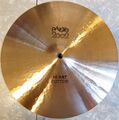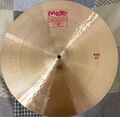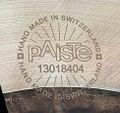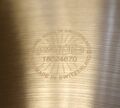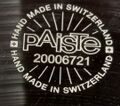Difference between revisions of "Paiste Serial Numbers"
| (132 intermediate revisions by 4 users not shown) | |||
| Line 1: | Line 1: | ||
__NOEDITSECTION__ | __NOEDITSECTION__ | ||
<div style="float:right">__TOC__</div> | <div style="float:right">__TOC__</div> | ||
| − | Paiste serial numbers were first applied | + | Paiste serial numbers were first applied during 1972. <br> |
| + | Prior to this there was no exact means of determining the age of a Paiste cymbal, there were more general indicators that would get you in the ball park age wise: the years of production for the series or model, lack of or presence of ink stamping, different version of the logo stamp, alloy used or even the size of the bell or mounting hole.<br> | ||
| + | These cymbals are referred to as "Pre-Serial" cymbals.<br> | ||
| − | + | *Important note: cymbals have been found '''without''' serial numbers stamped on them from production eras where we might expect them.<br> | |
| − | This does not apply to serial numbers on many prototypes, nor the German made Paistes | + | *This guide does not apply to serial numbers on many prototypes, nor the German made Paistes which seem to have been numbered from 1xxxxx up [https://www.cymbal.wiki/wiki/index.php?title=Paiste_Serial_Numbers&action=submit#.2A.2AGerman_serial_numbers.2A.2A <b>(see German serial number section below).]</b> <br> |
| − | == | + | *Sometimes serial numbers will be found from the year prior to the release year. For example, one Signature series cymbal was found with a 1988 stamp, and a Colorsound 900 cymbal was found with a 2016 stamp. One explanation for this would be that in order to get these cymbals to locations far from Switzerland, manufacturing had to begin in the previous year, to allow for a long shipping time. |
| + | |||
| + | == ? - 1971 preserial and transition models == | ||
| + | There is a Wiki section that helps determine the age of Formula 602's based on the stamp/emboss format: [https://www.cymbal.wiki/wiki/Paiste_Formula_602#Preserial_Era Preserial Era stamps]<br> | ||
| − | + | General rules to follow in determining the age of your Paistes:<br> | |
| − | * | + | * ? - early 60's?: Stambuls had the size and weight printed in red ink higher than 3:00 on the cymbal, closer to 2:30, (see example below), we don't have any examples of early 602's being stamped this way. |
| − | * | + | * ? - early 60's?: <font color="red">Red</font> "size" in inches followed by the "type/weight" ink stamp at 3 o'clock (for 602's). Some German Paistes have the size stamped in centimeters.<br> |
| − | * | + | *1963 - 1981: <font color="red">Red</font> "type/weight" ink stamp at 3 o'clock on standard weight models: Paper Thin, Thin, Thin Crash, Medium, Medium Ride, Heavy, Concert (excluding 2002's, giant beats and Sound Creations). <br> |
| + | *1971: "Paiste" name ink stamp now gets applied above the bell (probably with introduction of 2002 line which comes in late spring) on all Paiste lines and Ludwig cymbals (Standard and Stanople, Ludwig cymbals never get a series name stamp).<br> | ||
| + | |||
| + | *1972: Giant beats get the "Paiste" name ink stamp on the "black label" cymbals, they are never given a Paiste outline logo ink stamp on the bottom of the cymbal. | ||
| + | |||
| + | *1972: Serial numbers (on Swiss cymbals), series name ink stamp and Paiste outline logo ink stamp on bottom introduced, "True" Black Label era stamping begins.<br> | ||
| + | |||
| + | *Mid 60's - 1973: <font color="red">Red ink</font> diameter/size stamp under the bell until 1973 (or very late '72) and then it changes to '''Black''' for the reminder of Black Label phase (1973-1981) (vintage 602 SE Hats always had the black diameter stamp under the bell and the SE logo stamps on top were always black.).<br> | ||
| + | |||
| + | *1975: (or very late in 1974), the "Type/weight" stamp ink changes to '''Black''' for specialty type 602s only: seven sound set cymbals, Chinas, Flat Rides (Joe Morello cymbals now get the black signature stamp instead of the red stamps).<br><br> | ||
| + | |||
| + | <gallery> | ||
| + | File:602 preserial 14 HH.JPG|Preserial 602 hi-hats: only the "type" is stamped | ||
| + | File:1950s stambul.jpg|1950's NS12 Stambul with size & weight stamp @ ~2:00 | ||
| + | File:602 preserial 14 HH bttm 1.JPG|Preserial 602 hi-hats, size is in red ink under the bell | ||
| + | File:Stambul 65 metric.jpg|German Stambul with size in centimeters | ||
| + | File:18 thin cr 65.jpg|Preserial Stambul 65 "Thin crash" no name just weight printed in red | ||
| + | File:602 23 thin sisme.jpg| Preserial 602 23" thin | ||
| + | File:602 23 thin bottom sisme.jpg| 23" 602 thin bottom | ||
| + | File:60s 602 labels.jpg|1960's 602 production showing weight stamps | ||
| + | File:Factory stamping.jpg|Stamping in action | ||
| + | File:TXWADMj.jpg|Rubber ink stamps for all sizes and lines | ||
| + | </gallery> | ||
| + | |||
| + | '''Transition models''': | ||
| + | *There was a brief period (1971?) where preserial 602's and 2002's didn't have the series name stamped below the name "Paiste" <br><br> | ||
| + | |||
| + | <gallery> | ||
| + | File:602 23 thin.jpg|Transition 23" thin 602, no series name printed | ||
| + | File:Early 602 logo 23 thin.jpg|23" thin 602 close up: no series name printed | ||
| + | File:602 20 heavy prelogo sisme.jpg|Transition 602 20" "heavy" is labeled in red ink #200492 (early '72 production) | ||
| + | File:602 20 heavy prelogo sisme bottom.jpg|Size is stamped in red, no outlined "Paiste" logo | ||
| + | File:602 23 meduim transition sisme 222910.jpg|602 23" medium serial #222910 ('72 production) | ||
| + | File:602 23 meduim transition sisme bottom 222910.jpg|Bottom view: size is stamped in red, no outlined "Paiste" logo | ||
| + | File:S-l1600.jpg|Transition 602 w/solid stamp | ||
| + | File:PXL 20221228 020839223.jpg|Transition 602 23" heavy | ||
| + | File:602 transition ink.jpg|23" heavy w/solid stamp | ||
| + | File:23 Heavy 2.jpg|23" heavy w/solid stamp and 1974 serial number! | ||
| + | </gallery> | ||
| + | |||
| + | '''Preserial 2002's''': | ||
| + | *Very early production 2002's (1971) didn't have the series name stamped below the name Paiste, some didn't have the "Paiste" outline stamp on the underside of the cymbal either. | ||
| + | *The very 1st. cymbals off the production line had a "border" around the the 2002 stamp/emboss, we call this the "box stamp". We understand the box stamp emboss is the rarest of the rare when it comes to preserial 2002's. Our research has found that this emboss was difficult to apply and was quickly dropped in favor of the classic "open stamp" 2002 emboss we see throughout the 1970's into 1980 and early '81.<br><br> | ||
| + | |||
| + | <gallery> | ||
| + | File:2002 box stamp.jpg|Very early 2002 emboss "box stamp" | ||
| + | File:PXL 20221125 035539088.jpg|16" crash "box stamp" | ||
| + | File:PXL 20221125 035433296.jpg|16" crash bottom without "outline stamp" | ||
| + | File:Preserial 2002 3.jpg|Early ink stamp no "2002" name printed | ||
| + | File:Preserial 2002 2.jpg|preserial ink stamp no "2002" name printed | ||
| + | File:Preserial 2002 1.jpg|different angle, same cymbal | ||
| + | File:Preserial 2002 20.jpg|Full labels but no serial#, probably a preserial leftover that was stamped at a later date | ||
| + | File:Preserial 2002 marching.jpg|Preserial marching pair | ||
| + | File:312247684 10159404792355892 3675100819484314278 n.jpg|18" preserial medium | ||
| + | File:312441475 10159404792550892 4631165018851820600 n.jpg|18" preserial medium bottom with "outline stamp" | ||
| + | </gallery> | ||
| + | |||
| + | == 1972 - 1981: the Black label era== | ||
| + | Starting in 1972 there were six digit serial numbers stamped on each cymbal coming out of the Swiss plant:<br> | ||
| + | *The specific year is identified by the 'first' digit in the serial number. Some believe a leading 1 means 1971 (it does not), we haven't found one yet having checked thousands.<br> | ||
| + | |||
| + | *All 6 digit serials with a leading 1 check out as 1981 for Swiss made cymbals. The German versions from the 70's do start with a 1, but that isn't the year (see explanation below). <br> | ||
| + | |||
| + | *The 1970's serial numbers did not include the series name (602, 2002, Sound Creation, etc.) above the serial number.<br> | ||
| + | |||
| + | *Paiste Nottwil put serial numbers on the lower lines in 1972 and 1973 (Stambul, Stambul 65, Dixie and possibly the Super) up to about serial# 414xxx - probably after or in Jan/Feb 74. They then choose only to put serial numbers on the professional lines (Formula 602, 2002, Giant beat and later Sound Creation) for the rest of the Black Label era.<br> | ||
| + | |||
| + | *Most black label Swiss 404's and 505's didn't get serial #'s until mid '81 when they transitioned to colored logos.<br> | ||
| + | |||
| + | As a general rule for any Paiste line made in Switzerland: 6 digit numbers no series name above it, '72-early '81 production, first digit indicating year.<br> | ||
| + | 2xxxxx 1972<br> | ||
| + | 3xxxxx 1973<br> | ||
| + | 4xxxxx 1974<br> | ||
| + | 5xxxxx 1975<br> | ||
| + | 6xxxxx 1976<br> | ||
| + | 7xxxxx 1977<br> | ||
| + | 8xxxxx 1978<br> | ||
| + | 9xxxxx 1979<br> | ||
| + | 0xxxxx 1980<br> | ||
| + | 1xxxxx early 1981 | ||
<gallery> | <gallery> | ||
| − | File:1972 Formula 602 Serial.jpg|1972 | + | File:602 serial.jpg| Very early 1972 Formula 602 serial # |
| + | File:1972 2002 Hi Hat Serial.jpg|1972 2002 | ||
| + | File:1973 2002.jpg|1973 2002 | ||
File:1974 Formula 602 Serial.jpg|1974 Formula 602 | File:1974 Formula 602 Serial.jpg|1974 Formula 602 | ||
| − | |||
File:1975 2002 Serial.jpg|1975 2002 | File:1975 2002 Serial.jpg|1975 2002 | ||
File:1976_Formula_602_Serial.jpg|1976 Formula 602 | File:1976_Formula_602_Serial.jpg|1976 Formula 602 | ||
| − | File:1978 | + | File:1978 2002 Serial.jpg|1978 2002 |
File:1979 Sound Creation Serial.jpg|1979 Sound Creation | File:1979 Sound Creation Serial.jpg|1979 Sound Creation | ||
| − | |||
File:1980 2002 Serial.jpg|1980 2002 | File:1980 2002 Serial.jpg|1980 2002 | ||
| − | File: | + | File:1980 sound edge.jpg|Very early 1980 2002 production |
</gallery> | </gallery> | ||
| − | * | + | == **German serial numbers** == |
| + | German-made 2002's started receiving serial numbers from very late 1973 onwards (a few earlier 2002 examples exist).<br> | ||
| + | Some collectors are sure they have 1971 production 2002 cymbals with serial numbers starting with 1xxxxx, they are in fact German made 2002's with a different serial numbering format.<br> | ||
| + | <b>The German numbering system differs from the Swiss system in that that cymbals were numbered consecutively; the first digit does not equal the year!</b><br> | ||
| + | If you are looking at a German Black Label 2002 from the 1970s, the second digit is a good <b>general indicator</b> of the year (this also applies to all post '74 lower line German produced cymbals except the 101).<br> | ||
| + | |||
| + | *1972-74 the German factory not only made 2002s for the German market, they also helped the Swiss factory with exports of 2002s due to high demand. | ||
| + | |||
| + | *The German plant traditionally made all of the "lower line cymbals" up to the present, it is understood that the Stambul, Dixie and the Super got serial numbers from '75 and later. | ||
| + | |||
| + | *German Stambul 65's never got serials because they were discontinued by late '73 or early '74 (before serial numbers were applied). | ||
| + | |||
| + | *German 404's and 505's got serials from the start of production in late '77. | ||
| + | |||
| + | *Right before Paiste went to the printed color logos (1981) it looks like production increased substantially and they started going through serials at a faster rate so the "2nd digit = year" rule no longer applies!<br> | ||
| + | |||
| + | *Judging from the serial numbers, the German plant stopped producing 2002's in 1986 when the 3000 was introduced. | ||
| + | |||
| + | Here's a breakdown (dates are approximate):<br> | ||
| + | late 1973-1979 serial numbers : 13xxxx to 19xxxx<br> | ||
| + | *17xxxx is from around '77 or '78, a lower third digit (171xxx-174xxx) likely from '77 while a higher third digit (175xxx-179xxx) puts you around '78, serial# 196181 is from about '79.<br> | ||
| + | |||
| + | 1980 serial numbers: 20xxxx - 21xxxx<br> | ||
| + | |||
| + | 1981-1986 serial numbers: 22xxxx-3xxxxx <br> | ||
| + | *All 2oo2s with serial# 22xxxx and later are red labeled.<br> | ||
| + | *Confirmed specific dates from the German factory: serial# 2612xx produced in November '83, serial# 2984xx produced in October '84, serial# 3244xx produced in August '85.<br> | ||
| + | |||
| + | 1986-1990 serial numbers: 33xxxx-6xxxxx<br> | ||
| + | *example: #333994 '86, #418074 '87 or '88.<br> | ||
<gallery> | <gallery> | ||
| − | File:2002 | + | File:2002 german logo.jpg|80's "red label" German 2002 |
| − | File: | + | File:2002 german 73 serial.jpg| '73 German 2002 |
| − | File: | + | File:PXL 20220807 222033331.jpg|German preserial 2002 |
| + | File:242388532 580785073074778 5442261292214066663 n.jpg| German 2002 emboss/stamp | ||
| + | File:242392223 580785059741446 6922965537155192320 n.jpg|German 2002 serial# 173368 = mid 1977 production | ||
| + | File:German 505 203998.jpg|German 505 serial# 203998 = 1980 production (black label restamped as green label) | ||
| + | File:German 404 serial.jpg| German 404 serial# 251468 = approx. 1982 production | ||
| + | File:14 super.jpg|1978 NS12 German Super | ||
| + | File:German 2002 ride.jpg| red label 20" ride | ||
| + | File:85 german 2002 20 ride.jpg| 1985 2002 serial # | ||
</gallery> | </gallery> | ||
| − | + | ||
| − | == 1981 - 1986 == | + | == 1981 - 1986 colored labels begin == |
| − | + | Starting in 1981, "PAISTE" was stamped above the serial number, often along with the series name. (NOTE: This change occurred sometime during the year, some examples of the previous style exist with 1981 serial numbers.)<br> | |
| − | |||
*Like before, the ''first'' number indicates year - the following would be an example of 1982: | *Like before, the ''first'' number indicates year - the following would be an example of 1982: | ||
| − | |||
<center>PAISTE 2002</center> | <center>PAISTE 2002</center> | ||
<center> 234567 </center> | <center> 234567 </center> | ||
| + | *6 digits with plain PAISTE stamp:<br> | ||
| + | 1xxxxx remainder of 1981 (some early Color printed Logo '81 cymbals just have PAISTE above the number and not series name)<br> | ||
| + | 2xxxxx 1982<br> | ||
| + | 3xxxxx 1983<br> | ||
| + | 4xxxxx 1984<br> | ||
| + | 5xxxxx 1985<br> | ||
| + | 6xxxxx early 1986<br> | ||
| − | *Formula 602 | + | * During this time (mid/late '81) Paiste changed label colors on some of their series. [[Paiste Formula 602|Formula 602]] - Blue, [[Paiste 2002|2002]] - Red, [[Paiste 505|505]] - Green, among others.<br> |
| − | < | + | *The RUDE and Colorsound 5 names were NOT stamped after PAISTE.<br><br> |
| − | |||
| − | < | ||
| − | |||
<gallery> | <gallery> | ||
| − | File:1982_Sound_Creation_Serial.jpg| | + | File:1982 Formula 602 Serial.jpg|Formula 602 was shortened to simply "602" 1982 serial |
| − | + | File:1982_Sound_Creation_Serial.jpg|Sound Creation was located under PAISTE, due to space limitations 1982 serial | |
| − | + | File:1981 rude serial.jpg|1981 RUDE | |
| − | |||
| − | File:1981 | ||
File:1984 Colorsound 5 Serial.jpg|1984 Colorsound 5 | File:1984 Colorsound 5 Serial.jpg|1984 Colorsound 5 | ||
| − | |||
| − | |||
| − | |||
| − | |||
File:1982 Formula 602 Serial.jpg|1982 Formula 602 | File:1982 Formula 602 Serial.jpg|1982 Formula 602 | ||
| − | File: | + | File:505 1984 serial.jpg|1984 505 |
| − | |||
File:1984_Sound_Creation_Serial.jpg|1984 Sound Creation | File:1984_Sound_Creation_Serial.jpg|1984 Sound Creation | ||
| − | File: | + | File:404 serial number.jpg|1985 404 |
File:1985_2002_Serial.jpg|1985 2002 | File:1985_2002_Serial.jpg|1985 2002 | ||
File:1985_2002_Reflector_Serial.jpg|1985 2002 (Special Order Reflector finish) | File:1985_2002_Reflector_Serial.jpg|1985 2002 (Special Order Reflector finish) | ||
</gallery> | </gallery> | ||
| − | |||
| − | |||
== 1986 - 1990 == | == 1986 - 1990 == | ||
| − | + | During 1986 (probably when they launched all the new lines - [[Paiste 3000|3000]], [[Paiste 2000|2000]], [[Paiste 1000|1000]], etc.), "PAISTE" was stamped above the serial number, '''without''' series name. <br> | |
| − | |||
*Like before, the first number indicates year - the following would be an example of 1989: | *Like before, the first number indicates year - the following would be an example of 1989: | ||
| Line 82: | Line 194: | ||
<center>PAISTE </center> | <center>PAISTE </center> | ||
<center>901234 </center> | <center>901234 </center> | ||
| − | |||
<gallery> | <gallery> | ||
File:1986_2000_Colorsound.jpg|1986 2000 Colorsound | File:1986_2000_Colorsound.jpg|1986 2000 Colorsound | ||
File:1986 3000 Serial.jpg|1986 3000 | File:1986 3000 Serial.jpg|1986 3000 | ||
| + | File:1000 RUDE 20 Power Ride 4.jpg|1986 1000 RUDE | ||
File:1987_2002_Serial.jpg|1987 2002 | File:1987_2002_Serial.jpg|1987 2002 | ||
File:1987_Formula_602_Serial.jpg|1987 Formula 602 | File:1987_Formula_602_Serial.jpg|1987 Formula 602 | ||
| Line 92: | Line 204: | ||
File:1988_3000_Reflector_Serial.jpg|1988 3000 Reflector | File:1988_3000_Reflector_Serial.jpg|1988 3000 Reflector | ||
File:1989_Formula_602_Serial.jpg|1989 Formula 602 | File:1989_Formula_602_Serial.jpg|1989 Formula 602 | ||
| + | File:SigSer1989.jpg|1989 Signature | ||
| + | File:SigSerNum90.jpg|1990 Signature | ||
File:1990_Sound_Formula_Serial.jpg|1990 Sound Formula | File:1990_Sound_Formula_Serial.jpg|1990 Sound Formula | ||
</gallery> | </gallery> | ||
| − | |||
| − | |||
| − | |||
| − | |||
| − | |||
| − | |||
| − | |||
| − | |||
| − | |||
| − | |||
| − | |||
| − | |||
| − | |||
| − | |||
| − | |||
== 1990 - 1995 == | == 1990 - 1995 == | ||
| + | During 1990 the company name was changed to the 'high/low' style" "pAisTe". | ||
| − | + | *Therefore "pAisTe 345678" would be from 1993.<br><br> | |
| − | |||
| − | *Therefore "pAisTe 345678" would be from 1993. | ||
<gallery> | <gallery> | ||
| − | File:1990 3000 Serial.jpg|1990 3000 | + | File:1990 3000 Serial.jpg|1990 3000 with new high/low style |
File:1991_2000_Sound_Reflections_Serial.jpg|1991 2000 Sound Reflections | File:1991_2000_Sound_Reflections_Serial.jpg|1991 2000 Sound Reflections | ||
| + | File:1992 Signature Serial.jpg|1992 Signature | ||
File:1993 Formula 602 Serial.jpg|1993 Formula 602 | File:1993 Formula 602 Serial.jpg|1993 Formula 602 | ||
File:1993 Signature Serial.jpg|1993 Signature | File:1993 Signature Serial.jpg|1993 Signature | ||
| + | File:3000 1994 Serial.jpg|1994 3000 | ||
| + | File:Signature 1994 Serial.jpg|1994 Signature | ||
File:1995_2002_Serial.jpg|1995 2002 | File:1995_2002_Serial.jpg|1995 2002 | ||
| + | File:Sig20HBR_Serial.jpg|1995 Signature | ||
File:1995_2000 Sound Reflections_Serial.jpg|1995 2000 Sound Reflections | File:1995_2000 Sound Reflections_Serial.jpg|1995 2000 Sound Reflections | ||
</gallery> | </gallery> | ||
== 1995 - 2011 == | == 1995 - 2011 == | ||
| + | Sometime in 1995 Paiste started using <b>eight</b> digit serial numbers. In these cases, the first ''two'' digits represent the year of production. | ||
| − | + | *Therefore "96789012" would be from 1996.<br><br> | |
| − | |||
| − | *Therefore "96789012" would be from 1996. | ||
<gallery> | <gallery> | ||
File:1996_Sound_Formula_Serial.jpg|1996 Sound Formula | File:1996_Sound_Formula_Serial.jpg|1996 Sound Formula | ||
| − | File: | + | File:1997 Sound Formula serial.jpg|1997 Sound Formula |
| + | File:1998 2002 Serial.jpg|1998 2002 | ||
File:1999_Dimensions_Serial.jpg|1999 Dimensions | File:1999_Dimensions_Serial.jpg|1999 Dimensions | ||
File:2000_Signature_Serial.jpg|2000 Signature | File:2000_Signature_Serial.jpg|2000 Signature | ||
| + | File:2003_Signature_Serial.jpg|2003 Signature | ||
File:2004_2002_Serial.jpg|2004 2002 | File:2004_2002_Serial.jpg|2004 2002 | ||
| − | File: | + | File:SigSerNum2005.jpg|2005 Signature |
| − | File: | + | File:2008_Signature_Serial.jpg|2008 Signature |
File:2009_Dark_Energy_Serial.jpg|2009 Dark Energy | File:2009_Dark_Energy_Serial.jpg|2009 Dark Energy | ||
| − | File:File:2011 Formula 602 Serial.jpg|2011 Formula 602 | + | File:2010 Giant Beat Serial.jpg|2010 Giant Beat |
| + | File:2011 Formula 602 Serial.jpg|2011 Formula 602 | ||
</gallery> | </gallery> | ||
| − | + | *Starting in about 2005, "MADE IN SWITZERLAND" was added to the bottom logo of the 2002 cymbals.<br> | |
| − | *Starting in about 2005, "MADE IN SWITZERLAND" was added to the bottom logo of the 2002 cymbals. | ||
<gallery> | <gallery> | ||
| − | File:2002_Logo_Bottom_Switzerland.jpg| | + | File:2002_Logo_Bottom_Switzerland.jpg| |
</gallery> | </gallery> | ||
== 2011 - present == | == 2011 - present == | ||
| − | + | In the second half of 2011, Paiste started using a laser etched serial number on the cymbal's bottom side. | |
| − | + | *Numbers are not stamped on the top side from this point on. The first two numbers are still the year produced.<br><br> | |
<gallery> | <gallery> | ||
| − | File: | + | File:2011 Signature serial.jpg|2011 Signature |
| + | File:2012 Twenty Custom Serial.jpg|2012 Twenty Custom Serial | ||
| + | File:2013 2002 Serial.jpg|2013 2002 | ||
| + | File:2013 Signature Serial.jpg|2013 Signature | ||
File:2015_Signature_Serial.jpg|2015 Signature | File:2015_Signature_Serial.jpg|2015 Signature | ||
| − | File: | + | File:2016_Masters_Serial.jpg|2016 Masters |
| + | File:2017_Masters_Serial.jpg|2017 Masters | ||
File:2018_Giant Beat_Serial.jpg|2018 Giant Beat | File:2018_Giant Beat_Serial.jpg|2018 Giant Beat | ||
| − | File: | + | File:2019 2002 Serial.jpg|2019 2002 |
| − | File: | + | File:2020 2002 Serial.jpg|2020 2002 |
| + | File:2021 2002 Serial.jpg|2021 2002 | ||
</gallery> | </gallery> | ||
| + | ---------------------------------------------------- | ||
| + | Information from: Sean Walton, Todd Little, Steve Black, Dan Garza, Nils Lillig, Splash Baker.<br> | ||
| + | |||
| + | *Special thanks to Manuel Persiani for sharing his serial number pictures. | ||
| + | |||
| + | Return to the '''[[Paiste|Main Page]]<br> | ||
| + | Return to the '''[[Paiste Series|Paiste Series Portal]]<br> | ||
| + | Return to the '''[[Paiste Cymbal Type|Paiste Cymbal Type Portal]] | ||
Latest revision as of 05:54, 20 November 2024
Paiste serial numbers were first applied during 1972.
Prior to this there was no exact means of determining the age of a Paiste cymbal, there were more general indicators that would get you in the ball park age wise: the years of production for the series or model, lack of or presence of ink stamping, different version of the logo stamp, alloy used or even the size of the bell or mounting hole.
These cymbals are referred to as "Pre-Serial" cymbals.
- Important note: cymbals have been found without serial numbers stamped on them from production eras where we might expect them.
- This guide does not apply to serial numbers on many prototypes, nor the German made Paistes which seem to have been numbered from 1xxxxx up (see German serial number section below).
- Sometimes serial numbers will be found from the year prior to the release year. For example, one Signature series cymbal was found with a 1988 stamp, and a Colorsound 900 cymbal was found with a 2016 stamp. One explanation for this would be that in order to get these cymbals to locations far from Switzerland, manufacturing had to begin in the previous year, to allow for a long shipping time.
? - 1971 preserial and transition models
There is a Wiki section that helps determine the age of Formula 602's based on the stamp/emboss format: Preserial Era stamps
General rules to follow in determining the age of your Paistes:
- ? - early 60's?: Stambuls had the size and weight printed in red ink higher than 3:00 on the cymbal, closer to 2:30, (see example below), we don't have any examples of early 602's being stamped this way.
- ? - early 60's?: Red "size" in inches followed by the "type/weight" ink stamp at 3 o'clock (for 602's). Some German Paistes have the size stamped in centimeters.
- 1963 - 1981: Red "type/weight" ink stamp at 3 o'clock on standard weight models: Paper Thin, Thin, Thin Crash, Medium, Medium Ride, Heavy, Concert (excluding 2002's, giant beats and Sound Creations).
- 1971: "Paiste" name ink stamp now gets applied above the bell (probably with introduction of 2002 line which comes in late spring) on all Paiste lines and Ludwig cymbals (Standard and Stanople, Ludwig cymbals never get a series name stamp).
- 1972: Giant beats get the "Paiste" name ink stamp on the "black label" cymbals, they are never given a Paiste outline logo ink stamp on the bottom of the cymbal.
- 1972: Serial numbers (on Swiss cymbals), series name ink stamp and Paiste outline logo ink stamp on bottom introduced, "True" Black Label era stamping begins.
- Mid 60's - 1973: Red ink diameter/size stamp under the bell until 1973 (or very late '72) and then it changes to Black for the reminder of Black Label phase (1973-1981) (vintage 602 SE Hats always had the black diameter stamp under the bell and the SE logo stamps on top were always black.).
- 1975: (or very late in 1974), the "Type/weight" stamp ink changes to Black for specialty type 602s only: seven sound set cymbals, Chinas, Flat Rides (Joe Morello cymbals now get the black signature stamp instead of the red stamps).
Transition models:
- There was a brief period (1971?) where preserial 602's and 2002's didn't have the series name stamped below the name "Paiste"
Preserial 2002's:
- Very early production 2002's (1971) didn't have the series name stamped below the name Paiste, some didn't have the "Paiste" outline stamp on the underside of the cymbal either.
- The very 1st. cymbals off the production line had a "border" around the the 2002 stamp/emboss, we call this the "box stamp". We understand the box stamp emboss is the rarest of the rare when it comes to preserial 2002's. Our research has found that this emboss was difficult to apply and was quickly dropped in favor of the classic "open stamp" 2002 emboss we see throughout the 1970's into 1980 and early '81.
1972 - 1981: the Black label era
Starting in 1972 there were six digit serial numbers stamped on each cymbal coming out of the Swiss plant:
- The specific year is identified by the 'first' digit in the serial number. Some believe a leading 1 means 1971 (it does not), we haven't found one yet having checked thousands.
- All 6 digit serials with a leading 1 check out as 1981 for Swiss made cymbals. The German versions from the 70's do start with a 1, but that isn't the year (see explanation below).
- The 1970's serial numbers did not include the series name (602, 2002, Sound Creation, etc.) above the serial number.
- Paiste Nottwil put serial numbers on the lower lines in 1972 and 1973 (Stambul, Stambul 65, Dixie and possibly the Super) up to about serial# 414xxx - probably after or in Jan/Feb 74. They then choose only to put serial numbers on the professional lines (Formula 602, 2002, Giant beat and later Sound Creation) for the rest of the Black Label era.
- Most black label Swiss 404's and 505's didn't get serial #'s until mid '81 when they transitioned to colored logos.
As a general rule for any Paiste line made in Switzerland: 6 digit numbers no series name above it, '72-early '81 production, first digit indicating year.
2xxxxx 1972
3xxxxx 1973
4xxxxx 1974
5xxxxx 1975
6xxxxx 1976
7xxxxx 1977
8xxxxx 1978
9xxxxx 1979
0xxxxx 1980
1xxxxx early 1981
**German serial numbers**
German-made 2002's started receiving serial numbers from very late 1973 onwards (a few earlier 2002 examples exist).
Some collectors are sure they have 1971 production 2002 cymbals with serial numbers starting with 1xxxxx, they are in fact German made 2002's with a different serial numbering format.
The German numbering system differs from the Swiss system in that that cymbals were numbered consecutively; the first digit does not equal the year!
If you are looking at a German Black Label 2002 from the 1970s, the second digit is a good general indicator of the year (this also applies to all post '74 lower line German produced cymbals except the 101).
- 1972-74 the German factory not only made 2002s for the German market, they also helped the Swiss factory with exports of 2002s due to high demand.
- The German plant traditionally made all of the "lower line cymbals" up to the present, it is understood that the Stambul, Dixie and the Super got serial numbers from '75 and later.
- German Stambul 65's never got serials because they were discontinued by late '73 or early '74 (before serial numbers were applied).
- German 404's and 505's got serials from the start of production in late '77.
- Right before Paiste went to the printed color logos (1981) it looks like production increased substantially and they started going through serials at a faster rate so the "2nd digit = year" rule no longer applies!
- Judging from the serial numbers, the German plant stopped producing 2002's in 1986 when the 3000 was introduced.
Here's a breakdown (dates are approximate):
late 1973-1979 serial numbers : 13xxxx to 19xxxx
- 17xxxx is from around '77 or '78, a lower third digit (171xxx-174xxx) likely from '77 while a higher third digit (175xxx-179xxx) puts you around '78, serial# 196181 is from about '79.
1980 serial numbers: 20xxxx - 21xxxx
1981-1986 serial numbers: 22xxxx-3xxxxx
- All 2oo2s with serial# 22xxxx and later are red labeled.
- Confirmed specific dates from the German factory: serial# 2612xx produced in November '83, serial# 2984xx produced in October '84, serial# 3244xx produced in August '85.
1986-1990 serial numbers: 33xxxx-6xxxxx
- example: #333994 '86, #418074 '87 or '88.
1981 - 1986 colored labels begin
Starting in 1981, "PAISTE" was stamped above the serial number, often along with the series name. (NOTE: This change occurred sometime during the year, some examples of the previous style exist with 1981 serial numbers.)
- Like before, the first number indicates year - the following would be an example of 1982:
- 6 digits with plain PAISTE stamp:
1xxxxx remainder of 1981 (some early Color printed Logo '81 cymbals just have PAISTE above the number and not series name)
2xxxxx 1982
3xxxxx 1983
4xxxxx 1984
5xxxxx 1985
6xxxxx early 1986
- During this time (mid/late '81) Paiste changed label colors on some of their series. Formula 602 - Blue, 2002 - Red, 505 - Green, among others.
- The RUDE and Colorsound 5 names were NOT stamped after PAISTE.
1986 - 1990
During 1986 (probably when they launched all the new lines - 3000, 2000, 1000, etc.), "PAISTE" was stamped above the serial number, without series name.
- Like before, the first number indicates year - the following would be an example of 1989:
1990 - 1995
During 1990 the company name was changed to the 'high/low' style" "pAisTe".
- Therefore "pAisTe 345678" would be from 1993.
1995 - 2011
Sometime in 1995 Paiste started using eight digit serial numbers. In these cases, the first two digits represent the year of production.
- Therefore "96789012" would be from 1996.
- Starting in about 2005, "MADE IN SWITZERLAND" was added to the bottom logo of the 2002 cymbals.
2011 - present
In the second half of 2011, Paiste started using a laser etched serial number on the cymbal's bottom side.
- Numbers are not stamped on the top side from this point on. The first two numbers are still the year produced.
Information from: Sean Walton, Todd Little, Steve Black, Dan Garza, Nils Lillig, Splash Baker.
- Special thanks to Manuel Persiani for sharing his serial number pictures.
Return to the Main Page
Return to the Paiste Series Portal
Return to the Paiste Cymbal Type Portal

